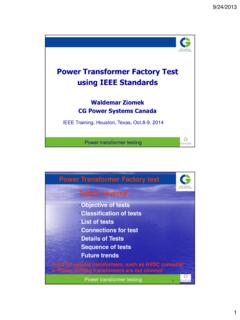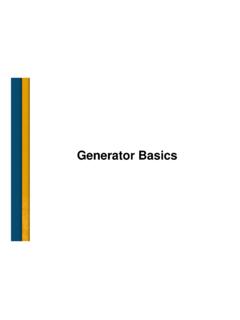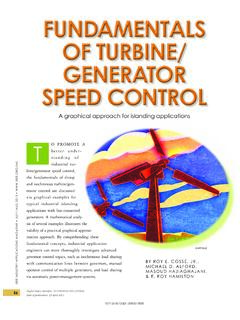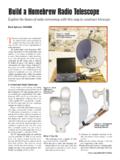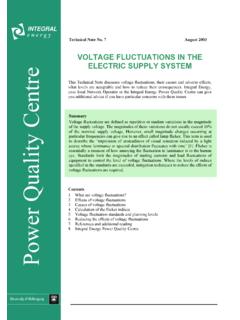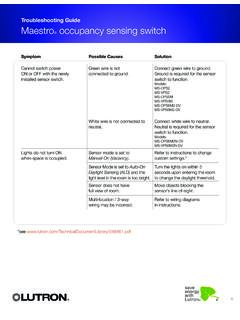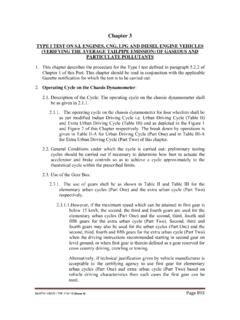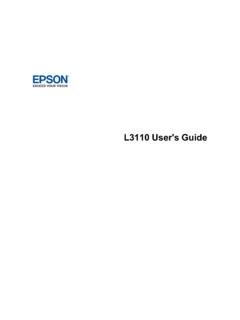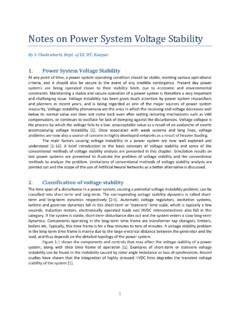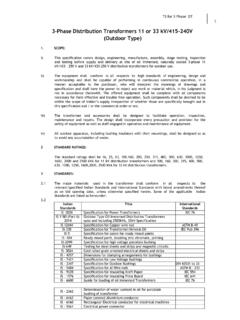Transcription of Power Transformer Fundamentals: Design and Manufacturing
1 Power Transformer Fundamentals: Design and Manufacturing Waldemar Ziomek, Engineering Manager CG Power Systems Canada Inc IEEE Training, Houston, Texas, , 2013. 1. Overview Transformer Design Transformer Types Construction and Parts Core & Coils Electrical Design Losses & Impedance Thermal, Dielectric & Short Circuit Cooling & Sound Level Mechanical Design Tank Oil Preservation Transformer Manufacturing Process 2. Power Transmission & Distribution The traditional Power supply chain - from the central Power generator to the consumer: GENERATION TRANSMISSION SUB-TRANSMISSION DISTRIBUTION DISTRIBUTED Power . 115/10 or 20 kV 500/230 230 132 345/161 161. 161 230/115 132. 230 230/132 115. 345 69. 500 34. Generator Step-Up Auto- Transformer Step-Down Pads Transformer Transformer With and without LTC.
2 3. Specification vs. Design SPECIFICATION GIVES BASIC. PARAMETERS: Voltages (kV, BIL) , Power rating ( MVA), impedance (IZ), . DESIGNER/PRODUCER GIVES: Dielectric system Magnetic system Thermal system Mechanical system Oil flow system'. Sound system'. 4. Standards USA. (ANSI) IEEE Std , standard general requirements for liquid- immersed distribution, Power and regulation transformers ~ 50 Pages ANSI , safety requirements 230 kV and below 833/958 through 8,333/10,417 KVA, single-phase, and 750/862 through 60,000/80,000/100,000. KVA, three-phase without load tap changing; and 3,750/4,687 through 60,000/80,000/100,000 KVA with load tap changing ~ 30+ Pages (ANSI) IEEE , standard test code for liquid-immersed distribution, Power and regulating transformers and guide for short-circuit testing of distribution and Power transformers ~ 107 Pages NEMA standards publication no.
3 TR1-1993; transformers, regulators and reactors ~ 2 Pages CSA. IEC. 5. Simple Transformer Left coil - input (primary coil). AC Source is connected to Magnetizing current flows and establishes the flux in core Right coil - output (secondary coil). load Magnetic circuit (core). Problems ? Stray flux, transients, heating, vibrations, noise, losses, regulation, saturation, human errors, dielectrics (high voltage insulation), non-linear magnetics, fluid dynamics, material defects, contamination, 6. Real single phase Transformer Wound leg LV winding HV winding Return core leg In order to better control the stray flux distribution, both windings are wound on same core leg 7. Equivalent Circuit Rp+jXp Rs+jXs load Xm Rm Rp+Rs ' Xp+Xs'. load Xm Rm 8.
4 Transformer Design Basis Thermal Dielectric Short Circuit Quality Reliability Consistent performance Long Service life 9. Design Procedure Select Core Diameter & Area (A). Select Maximum Flux Density (Bm). Find Volts/Turn = x Freq x Bm x A. Find LV Turns = LV volts per Phase/ (V/T). Find HV Turns = HV volts per Phase/ (V/T). Select current densities LV & HV. Select Conductor Area = Current / Density Select type of Winding: Helical,Disc,Center-fed,end-fed Finalize HV Axial & Radial Finalize LV Axial & Radial 10. Design Procedure Select Core - LV; LV-HV Ducts Draw Ampere - Turn diagram Find Impedance % : I T 2 k lavg a1 a2 10 4. ux xk f N R %. SN h 3 3 . a1 a2 . kR 1 . h 1, 2, - radial dimensions of two windings and the gap lavg = D1-2 where D1-2 = OD1+.
5 Check with guaranteed impedance, adjust V/T, height to get required impedance Finalize frame size- CD x WH x LC. Find Iron Loss Find load Loss Check for short circuit withstand Check for thermal withstand Check for impulse withstand 11. Design Optimization Transformer parameters as a function of core diamater Height [m]. 200 10. 180 9. Cu [ton]. 160 Fe[ton] 8. Active part [ton]. Height [m]. 140 7. 120 6. Mass [x 1000 kg]. Active part 100 5. 80 4. Height Core 60 3. Copper 40 2. 20 1. 0 0. 700 800 900 1000 1100 1200 1300. Core diamater [mm]. 12. Design Optimization Winding which are closer to each other have lower impedance. The taller the winding the lower the impedance. Impedance is changing in Power two with the number of turns. Transformer impedance expressed in Ohms is independent from MVA base 13.
6 Construction Type and Main Parts Core- or Shell Form Windings Circular for core-type , Pancake for shell-type Solid Insulation (turn-to-turn, section-to- section, winding-to winding, coil-to- core/clamp). Insulating liquid (coolant and main insulation). Tank Cooling equipment (radiators, coolers). 14. Shell Form 1. high voltage bushing 2. tank top section 3. cooling equipment 4. oil circulating pump 5. tank bottom section 17. pancake coil 18. inter-phase block 19. coil group 20. coil group 24. tank shielding 25. insulating washer 15. Core Form Concentric windings Set' Winding Geometry Cooling options Cost consideration Shipping differences 16. Core Form 17. Types of Cores 3 legs 1 wound leg 2 return legs Type 1 legs and yokes not of equal cross section single-phase 2 legs 2 wound legs Type 2 legs and yokes of equal cross section single-phase 3 legs 3 wound legs Type 3 legs and yokes of equal cross section three-phase 18.
7 Types of Cores cont. 4 legs 2 wound legs Type 4 2 return legs legs and yokes not of equal cross section single-phase 5 legs 3 wound legs 2 return legs legs and yokes not of equal cross section Type 5 three-phase 19. Core Cutting Core Form Design . Fully mitered & step lapped in corner joints improves flux distribution, minimizes losses & sound level Circular core shape provides windings with optimum radial support 20. Core Stacking Methods BUTT-LAP STACKING: Local concentration of flux higher excitation current & core loss STEP-LAP STACKING: Reduced Local flux concentration lower excitation current & core loss Core Material- Grain Oriented Silicon M - NON-LS; H - LS H. ZDKH (laser scribed). ZDMH (mechanically scribed). 21. Tie-rod Based Clamping Systems 22.
8 Tie-plates and Clamping Beams 23. Winding Types Layer / Barrel Layer / Barrel Mostly buried TV. Good space factor Cooling only on vertical surfaces 24. Winding Types - Helix Helical Winding Inner windings Axial ducts allow for cooling on horizontal surface 25. Winding Types - Helix 26. Winding Types - Multistart Multistart Winding Used mainly for LTC He taps lec Single or two layer 27. Winding Types - Multistart 28. Winding Types Tapped Disc / Helix Tapped Disc / Helix Used mainly for outer LTC or DTC windings Can be used internally, eccentric duct Two symmetrical halves Problems with impulse 29. Winding Types Tapped Disc / Helix 30. Winding Types Disc Winding Disc Winding Used for inner and outer windings 31. Winding Types Disc Winding 32.
9 Winding Types Interleaved Disc Interleaved Disc Winding Improve impulse distribution Various forms of interleaving 33. Winding Types Shielded Disc Shielded Disc Winding Alternative to interleaving No joins in the winding conductor 34. Winding Types Shielded Disc 35. Magnet Wire, Paper Insulated 36. CTC - Epoxy Bonded, Netting Tape 37. Losses & Impedance No load losses: Hysteresis and eddy losses in Transformer core load losses: DC Losses Resistive loss in winding conductor Eddy Losses Produced by stray flux in the windings when current is drawn from the Transformer Stray Losses Eddy losses in constructional parts (clamps, tank wall, etc). Impedance Dependent upon geometry, amp-turns, base Power rating and frequency Effect on short circuit currents/forces 38.
10 Eddy Losses in Conductor Eddy loss factor per unit of volume : Bm W. 2. Peddy . V 2 2 m3. where 2 d H . 2 f ; ; ; 4 10 7 ; 10 9. m m sh sin . Bm ;. ch cos . d for d , then 3 . Peddy 2 2 2 2. f d Bm d V 6. 39. Sound Level Magnetostriction - varying magnetic flux produces vibrations at fundamental frequency of 120 Hz for 60Hz Power frequency ( or 100 Hz at 50Hz Power ). Sound level depends on: - core material - flux density in core - core weight - sound level increases proportionally to log (weight), - tank Design and cooling system (# and type of fans, pumps). Measured at m for core alone and at 2 m for top rating (with whole cooling equipment on). Sound level under load becoming a new requirement 40. Stray Flux Distribution CORE. LV HV.



